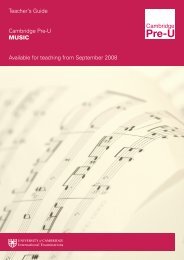Cambridge Pre-U Syllabus - Cambridge International Examinations
Cambridge Pre-U Syllabus - Cambridge International Examinations
Cambridge Pre-U Syllabus - Cambridge International Examinations
You also want an ePaper? Increase the reach of your titles
YUMPU automatically turns print PDFs into web optimized ePapers that Google loves.
30<br />
3.3 Nerves, muscles and behaviour<br />
Content<br />
The nervous system<br />
Nerves and synapses<br />
The brain<br />
Muscles<br />
Innate and learned behaviour<br />
Social behaviour in primates<br />
<strong>Cambridge</strong> <strong>Pre</strong>-U Draft<br />
Learning outcomes<br />
Candidates should be able to:<br />
a) describe the organisation of the central and peripheral nervous systems to include transverse section of<br />
the spinal cord<br />
b) describe the structure and function of sensory and motor neurones<br />
c) describe the production of the resting potential and the generation and transmission of action potentials<br />
in myelinated and unmyelinated neurones<br />
d) discuss the factors affecting the speed of impulse transmission in neurones (limited to neurone<br />
diameter, body temperature and myelination)<br />
e) describe and explain transmission at chemical synapses including antagonistic excitatory and inhibitory<br />
neurotransmitters as exemplified by acetylcholine, noradrenaline and GABA<br />
f) outline the gross anatomy and functions of the brain (limited to the cerebrum (cerebral hemispheres),<br />
thalamus, hypothalamus, midbrain, hind brain (to include the medulla oblongata, pons varolii and<br />
cerebellum) the pituitary body, and cerebro-spinal fluid<br />
g) explain dementia and research into its possible causes, symptoms and treatments including stem cells<br />
h) describe the structure and functioning of the neuromuscular junction and propagation of the action<br />
potential across muscle cells<br />
i) describe the histology and ultrastructure of striated muscle and relate this to its contraction<br />
j) describe and explain the sliding filament theory of muscle contraction to include the roles of calcium<br />
ions, ATP, actin, myosin, troponin and tropomyosin<br />
k) explain the advantages of innate and learned behaviours to organisms<br />
l) describe examples of genetically determined innate behaviours including taxes, kineses, withdrawal<br />
reflexes and instinctive behaviours (limited to foraging in Drosophila)<br />
m) describe examples of learned behaviours widespread in the animal kingdom including habituation,<br />
imprinting, classical conditioning and operant conditioning<br />
n) describe examples of social behaviour in primates and discuss the advantages of such behaviour<br />
Practical learning outcomes<br />
Candidates should be able to:<br />
i) explain the relationship between structure and function of spinal cord, brain (cerebral hemispheres and<br />
cerebellum only), nerves, myelinated neurones, synapses, neuromuscular junctions and striated muscle<br />
using histological sections and electronmicrographs<br />
ii) investigate innate behaviour using choice chambers and suitable motile invertebrates<br />
iii) use simple T mazes to investigate operant conditioning using suitable motile invertebrates

















